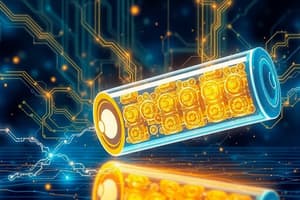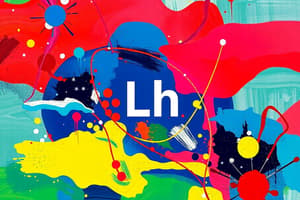Podcast
Questions and Answers
What is a product formed when chlorine is passed through cold, dilute aqueous sodium hydroxide?
What is a product formed when chlorine is passed through cold, dilute aqueous sodium hydroxide?
- NaClO and NaClO4
- NaCl and NaClO3
- NaCl and NaClO (correct)
- NaClO and NaClO3
Which of the following is NOT a product when potassium iodide reacts with concentrated sulfuric acid?
Which of the following is NOT a product when potassium iodide reacts with concentrated sulfuric acid?
- SO3
- I2
- H2S
- NaCl (correct)
What change would be expected to increase the time taken for solid sulfur to appear when sodium thiosulfate reacts with hydrochloric acid?
What change would be expected to increase the time taken for solid sulfur to appear when sodium thiosulfate reacts with hydrochloric acid?
- Increasing the concentration of the hydrochloric acid
- Decreasing the concentration of the sodium thiosulfate
- Increasing the temperature (correct)
- Adding a catalyst
What happens when the temperature is increased at constant pressure in a reversible reaction involving PCl3 and Cl2 to form PCl5?
What happens when the temperature is increased at constant pressure in a reversible reaction involving PCl3 and Cl2 to form PCl5?
What is the maximum volume, in dm3, measured at room temperature and pressure (r.t.p.), of gas produced from 3.69 g of lithium carbonate?
What is the maximum volume, in dm3, measured at room temperature and pressure (r.t.p.), of gas produced from 3.69 g of lithium carbonate?
How many molecular ion peaks are there in the mass spectrum of 1,2-dichloroethane containing isotopes 1H, 12C, 35Cl, and 37Cl?
How many molecular ion peaks are there in the mass spectrum of 1,2-dichloroethane containing isotopes 1H, 12C, 35Cl, and 37Cl?
In the reaction where graphite burns to form carbon monoxide, which of the following is correct?
In the reaction where graphite burns to form carbon monoxide, which of the following is correct?
What is the effect of increasing pressure at constant temperature on the rate of reaction and yield of PCl5(g)?
What is the effect of increasing pressure at constant temperature on the rate of reaction and yield of PCl5(g)?
When a chloroalkane is heated with dilute aqueous sodium hydroxide and the pure organic product shows no change in color when warmed with acidified potassium dichromate(VI) solution, which chloroalkane could it be?
When a chloroalkane is heated with dilute aqueous sodium hydroxide and the pure organic product shows no change in color when warmed with acidified potassium dichromate(VI) solution, which chloroalkane could it be?
In the context of two isomeric alcohols and two isomeric carbonyl compounds, which reaction is possible?
In the context of two isomeric alcohols and two isomeric carbonyl compounds, which reaction is possible?
Which compound would be expected to give a significant peak at m/z = 31 in its mass spectrum among the given options?
Which compound would be expected to give a significant peak at m/z = 31 in its mass spectrum among the given options?
If propanal is reduced instead of oxidized in a chemical reaction involving two isomeric alcohols and carbonyl compounds, what would be the expected outcome?
If propanal is reduced instead of oxidized in a chemical reaction involving two isomeric alcohols and carbonyl compounds, what would be the expected outcome?
What would be the effect on the yield of PCl5(g) if the pressure is decreased at constant temperature?
What would be the effect on the yield of PCl5(g) if the pressure is decreased at constant temperature?
Which statement about the reactivity of halogens is correct?
Which statement about the reactivity of halogens is correct?
A white solid X produces a red color in a flame test and forms a cream precipitate with silver nitrate that dissolves in ammonia. What is the formula of X?
A white solid X produces a red color in a flame test and forms a cream precipitate with silver nitrate that dissolves in ammonia. What is the formula of X?
If 50.0 cm³ of 2.00 mol dm⁻³ nitric acid reacts with 50.0 cm³ of 1.00 mol dm⁻³ barium hydroxide, what is the concentration of the resulting barium nitrate solution?
If 50.0 cm³ of 2.00 mol dm⁻³ nitric acid reacts with 50.0 cm³ of 1.00 mol dm⁻³ barium hydroxide, what is the concentration of the resulting barium nitrate solution?
If a burette has an uncertainty of ± 0.05 cm³, what is the percentage uncertainty in measuring 50.00 cm³ of a solution?
If a burette has an uncertainty of ± 0.05 cm³, what is the percentage uncertainty in measuring 50.00 cm³ of a solution?
Which halogen is least reactive?
Which halogen is least reactive?
Which ion is the strongest reducing agent?
Which ion is the strongest reducing agent?
What is the standard enthalpy of formation, $\Delta_f H$, of carbon monoxide?
What is the standard enthalpy of formation, $\Delta_f H$, of carbon monoxide?
What is the standard enthalpy of combustion, $\Delta_c H$, of carbon?
What is the standard enthalpy of combustion, $\Delta_c H$, of carbon?
Which type of intermolecular force is the strongest in solid hydrogen iodide, HI?
Which type of intermolecular force is the strongest in solid hydrogen iodide, HI?
Which of the given reactions is a disproportionation reaction?
Which of the given reactions is a disproportionation reaction?
Which of the given reactions is an acid-base reaction?
Which of the given reactions is an acid-base reaction?
Which statement about the stability and solubility of barium and magnesium compounds is correct?
Which statement about the stability and solubility of barium and magnesium compounds is correct?




